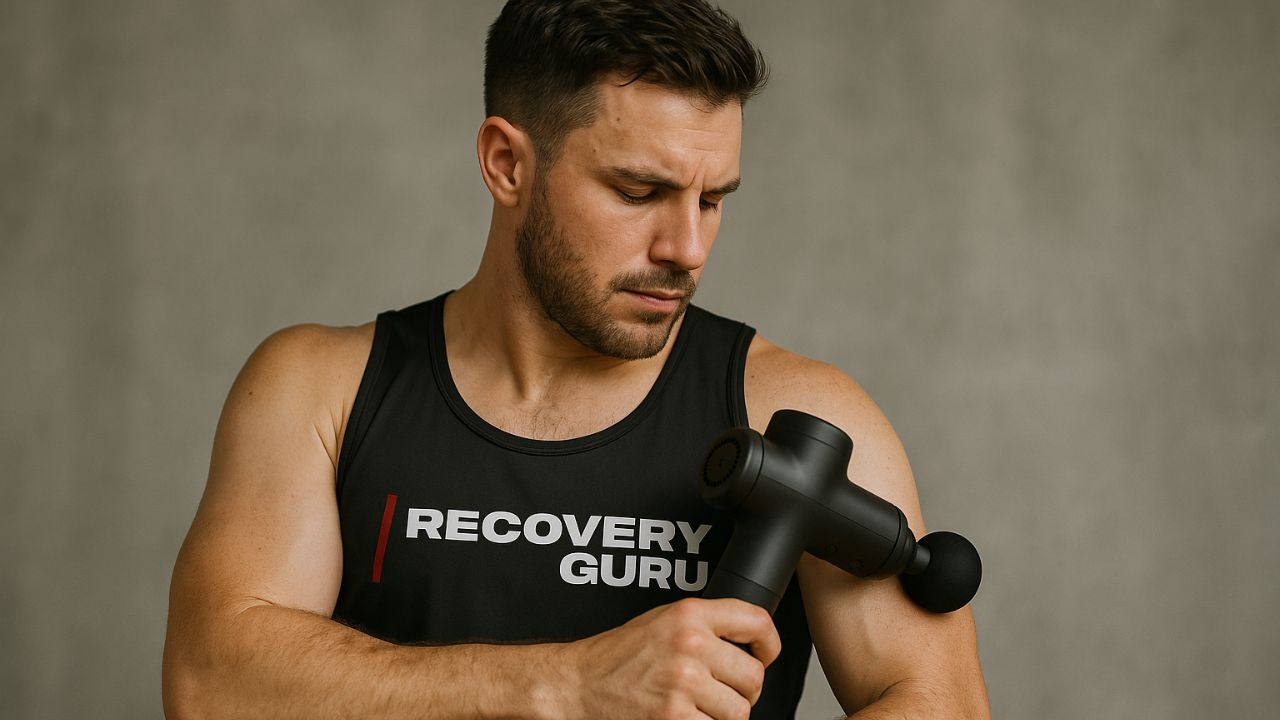Our buyer's guides are based on years of collective experience from our health enthusiasts, fitness experts, and real-world input from our community. They reflect informed perspectives, not sponsored endorsements.
Massage guns – also known as percussive therapy devices – have exploded in popularity over the last few years. If you’re into fitness or follow wellness trends, you’ve probably seen these handheld devices that look a bit like power drills, rapidly pulsing against sore muscles.
A massage gun uses rapid percussion (vibrations or thumping movements) to stimulate muscle tissue, promote blood flow, and help relieve muscle knots or soreness. In essence, they allow you to give yourself a deep-tissue massage at home or on the go. By 2025, the market is filled with dozens of models ranging from budget-friendly basic massagers to high-end smart devices.
This buyer’s guide will walk you through everything you need to know before buying a massage gun: the benefits, key specs and features to consider, and how to choose the right one for your needs. Whether you’re an athlete looking to speed up recovery, or someone who sits at a desk all day and needs relief from muscle tension, a massage gun could be a game-changer – but it’s important to pick the right one and use it properly.
Quick Checklist of Questions Before Buying:
Does it have the power and amplitude I need for my muscle mass and preferences?
Is it a comfortable weight and design for me to use on myself?
How many attachments does it include, and are they the ones I find useful?
What is the battery life, and will that cover my typical usage pattern?
Is it quiet enough for where/when I plan to use it?
Do I care about smart features or is a basic model okay?
Is the brand reputable, and what’s the warranty?
Does it fit my budget, and is it the best value in that price range?
By answering these, you can narrow down your choices significantly. Scroll down further for the detailed guide.
Why Use a Massage Gun? (Benefits and Uses)
Massage guns have gained a devoted following for several good reasons. Here are some of the main benefits and uses of these devices:
Muscle Recovery and Soreness Relief: After intense exercise or even long hours of sitting, muscles can feel tight, sore, or knotted. A massage gun provides rapid percussive pressure that can help loosen tight muscle fibers and fascia. This may reduce delayed onset muscle soreness (DOMS) and help you recover faster between workouts. Many athletes use massage guns as part of their cool-down routine or on rest days to alleviate stiffness.
Improved Circulation: The percussive action of a massage gun stimulates blood flow to the targeted area. Better circulation means more oxygen and nutrients are delivered to the muscle, which can aid in healing and reduce inflammation. Improved blood flow can also just make your muscles feel rejuvenated and warmer (great on a cold day or when you feel stiff).
Increased Range of Motion and Flexibility: By breaking up adhesions and reducing muscle tension, massage guns can help increase your flexibility. For example, using a massage gun on your calves or hamstrings might allow you to stretch a bit deeper afterward. Many physical therapists incorporate percussive therapy to prep muscles before stretching exercises.
Convenience and Self-Care: Perhaps one of the biggest selling points is that you can use a massage gun by yourself, whenever you need it. You don’t have to schedule a massage therapist appointment or rely on someone to give you a rub-down. The device can reach many areas of the body (legs, glutes, arms, back, etc.) and often comes with different attachments to customize the massage. It’s like having a personal masseuse on-call. In 2025, some massage guns even have smartphone apps that guide you through routines for specific muscle groups or conditions.
Pain Relief and Injury Prevention: Regular use of a massage gun on problem areas can help manage chronic muscle pain or knots (for example, those pesky trigger points in your upper back or the IT band tightness on your thigh). By keeping muscles supple and relieving minor aches early, you might prevent them from turning into more serious injuries. Of course, massage guns are not a cure-all and shouldn’t be used on acute injuries without guidance, but for muscle tension and general soreness, they’re a handy tool.
In short, massage guns serve anyone from high-performance athletes to casual gym-goers to people with sedentary jobs. They deliver many benefits of a massage in a quick, portable form. Now that we know why they’re useful, let’s dive into what to look for when buying one.
Key Factors to Consider When Buying a Massage Gun
Not all massage guns are created equal. As you shop around, you’ll notice a variety of specifications and features. Here we break down the most important factors you should consider:
1. Amplitude (Depth of Massage)
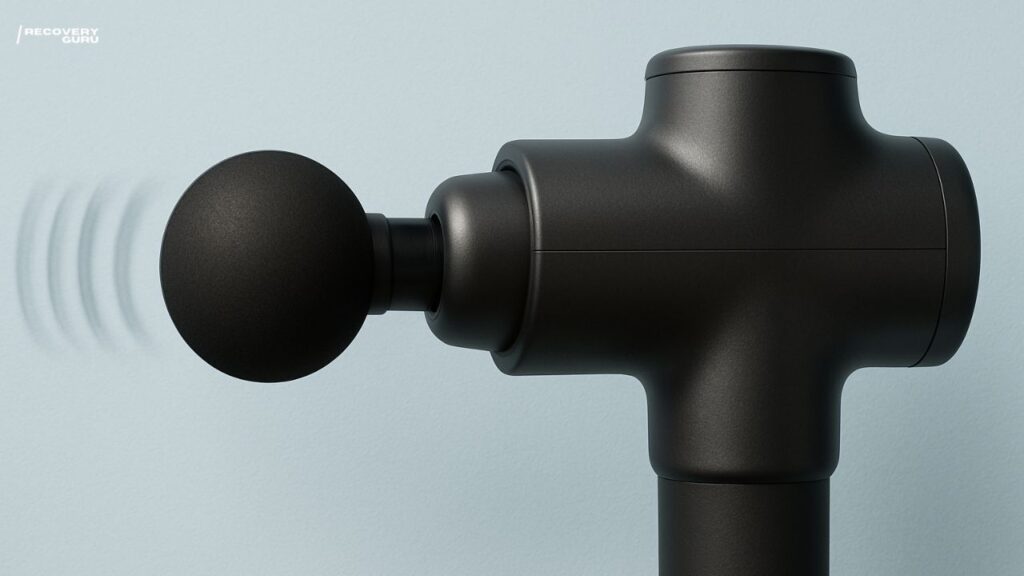
Amplitude refers to how far the massage gun’s head travels back and forth with each percussion stroke. In simple terms, it’s the depth of the massage. Amplitude is usually measured in millimeters (mm). Massage guns with a larger amplitude (12-16mm) deliver a deeper stroke, meaning they can penetrate further into muscle tissue. This is often desirable for a true deep-tissue massage effect, especially on large muscle groups like the quads or glutes.
Devices like the Theragun series are known for around 16mm amplitude, giving a very punchy, intense massage. On the other hand, massage guns with a smaller amplitude (8-10mm or less) produce a more surface-level vibration feeling. They still provide relief but in a slightly different way – more of a buzzing massage than a deep punch. Smaller amplitude can be gentler and often these devices can run at higher speeds to compensate.
Think about your needs: if you have very dense muscle mass or prefer a strong massage, look for higher amplitude. If you are more sensitive or want something for everyday tension relief, a moderate amplitude might suffice. Manufacturers will sometimes list amplitude in their specs. If not, you can sometimes gauge by the design (larger, bulkier guns often have higher amplitude).
In 2025, many mid-range guns have around 10mm amplitude which is a nice middle ground for most users.
2. Stall Force (Power of the Motor)
Stall force is essentially the force (usually measured in pounds or kilograms of pressure) at which the massage gun’s motor will stall (stop moving). It indicates how much pressure you can apply to your muscle with the gun before it gives out. A higher stall force means a more powerful motor that can handle you pressing it firmly against tight muscles without stopping. For heavy muscle work or for well-trained athletes with bulkier muscles, a high stall force is important – you don’t want the device to quit when you lean into a knot in your hamstring. Top-tier massage guns often advertise stall forces in the range of 40-60 lbs (18-27 kg) or more.
Budget models might stall at 20 lbs or lower. To visualize: 40-60 lbs is a lot of pressure (more than most people will ever exert), whereas 20 lbs is easier to hit if you press hard. If you know you like to dig in on trigger points, go for a higher stall force. If you just plan on light pressure or massaging gently, stall force won’t be a big limiting factor. Keep in mind, more stall force often means a bigger, heavier motor and potentially a louder device – it’s a trade-off. Brands might not always list an exact stall force, but you can infer power from user reviews or by comparing models (flagship models from known brands tend to have the highest stall force).
3. Speed Settings (Percussions Per Minute)
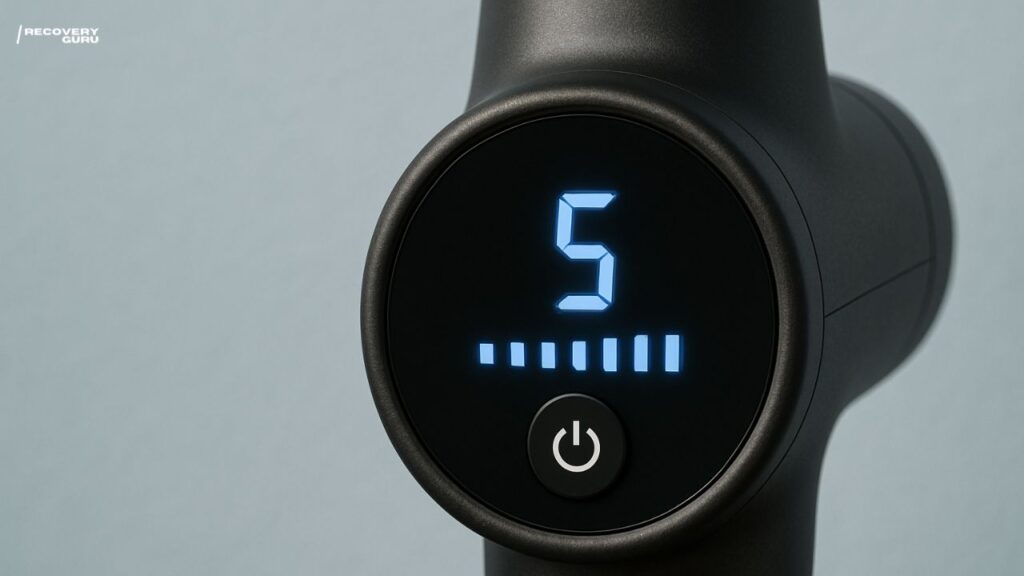
Massage guns have different speed settings, usually indicated in percussions per minute (PPM) or sometimes “RPM” in specs, which is essentially the same idea. This is how fast the head oscillates. Common ranges are from about 1,800 up to 3,200 percussions per minute. Most devices come with multiple speed settings (for example, Level 1: 1800 ppm, Level 2: 2100 ppm, Level 3: 2500 ppm, etc.). Some high-end guns have fine-grained control or even continuously variable speed via an app. Why does speed matter? A lower speed with a high amplitude can feel like a heavy, deliberate massage stroke – good for targeting a deep knot.
A higher speed with lower amplitude feels more vibrational and is good for warming up muscles or finishing off with a flush. It’s beneficial to have at least a few speeds to choose from, since different muscles or conditions respond better to different rhythms. Beginners might start on lower speeds until they get used to the sensation. When shopping, check how many speed levels a gun offers and the max speed.
More isn’t always better, but typically a range of 3-5 speeds is useful. Some very cheap guns offer many speeds (like 20+) but that can be overkill or sometimes it’s just marketing (the difference between level 12 and 13 might be negligible). Focus on the range: Does it have a gentle setting and an intense setting? Also, consider if the controls for speed are easy to use (one-button cycle vs. digital display, etc.).
4. Attachments and Massage Heads
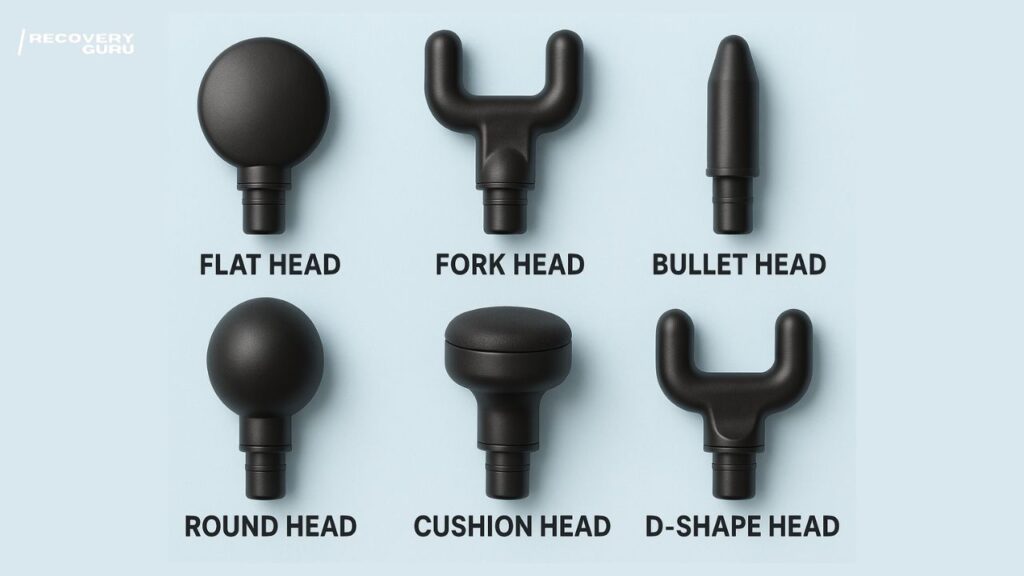
Nearly all massage guns come with interchangeable attachment heads that you can swap out for different purposes. The variety and quality of these attachments is a key factor:
Ball Head: Often made of foam or rubber, this is a general-purpose attachment great for large muscle groups (thighs, glutes, calves). It’s forgiving and spreads the pressure out.
Flat Head: A flat, usually plastic head that provides a firm, broad pressure. Good for dense areas like pecs or back muscles. It doesn’t dig in too much, so it’s more comfortable on areas that are more sensitive.
Bullet (Pointed) Head: A small, bullet-shaped attachment for trigger points or very pinpoint massage. Ideal for knots or hard-to-reach spots near shoulder blades (but be cautious, it’s intense due to the focused pressure).
Fork (U-Shaped) Head: This has a two-pronged shape, designed to go around tendons or bony areas. Commonly used for the neck (avoiding the spine itself by having the two prongs massage on either side) or along the Achilles tendon. Also used on the spine area with caution.
Cushioned Head: Some kits include a softer attachment (air-filled or foam) for extra sensitive areas or beginners. This one can be nice for around joints or bones where you need a gentler touch.
Wedge or Shovel Head: A flatter, spade-like attachment for scraping along muscles – sometimes used on IT band or shoulders for a flushing motion.
When comparing products, see how many attachments are included and if they seem useful for your needs. More attachments doesn’t automatically mean better, but having at least 3-4 options is great for versatility. Quality matters too: good attachments are made of durable material that won’t wear out quickly.
If you have specific issues (for example, plantar fasciitis), you might look for a gun that includes a suitable head (like a small ball for foot arches). The good news is, many attachment heads have standard fittings, and you can often buy third-party attachments later if needed. But it’s nice to get a complete set in the box.
5. Battery Life and Charging
Massage guns are cordless and rely on a rechargeable battery. Battery life can vary widely. High-end guns often boast 2 to 3 hours of use per charge, whereas cheaper ones might only manage 1 to 1.5 hours. Keep in mind, the quoted battery life is usually at the lowest speed setting without much pressure applied. If you run it on max speed and really press in, actual battery time will be less. Consider how you plan to use the device: Most sessions might be 10-15 minutes on various body parts. Even a 1-hour battery would cover several sessions before needing a charge. However, if you’re a professional (say a therapist using it on multiple clients) or you travel a lot with it, longer battery life is a plus.
Some advanced models in 2025 have interchangeable batteries – for example, a removable battery pack that you can swap out. This is great if you want effectively unlimited use (you charge one battery while using another). It also can extend the product’s life if the battery degrades; you could replace just the battery. Check the charging method too: is it a standard DC plug, USB-C (some newer mini guns charge via USB, handy for travel), or a charging dock? Charging time matters as well – big batteries might take 2-3 hours to fully charge. Generally, battery tech has improved and many guns use lithium-ion batteries that hold charge well. If the product lists battery capacity (in mAh or V), it might give an idea (e.g., 2500mAh is decent, 3000+ mAh is quite good). But user reviews are often the best indicator of real-world battery performance.
6. Size, Weight, and Ergonomics
Take note of the size and weight of the massage gun, as well as the design of its handle. A device might have great specs on paper, but if it’s too heavy or awkward to hold, you won’t use it much. Full-size, powerful massage guns typically weigh between 2 to 3 pounds (around 1-1.5 kg). That weight is necessary to house a strong motor and battery, but it can cause some hand fatigue if you’re using it for extended periods or trying to reach tricky spots on your back. If you’re primarily going to use it on yourself, consider how easy it will be to maneuver. Some brands (like Theragun) use a unique angled handle or triangular multi-grip design, which allows different ways to hold the device comfortably.
This can be helpful to reach areas like the middle of your back. Other models have a simple horizontal handle (like a T-shape or pistol grip). Try to imagine or, if possible, physically try holding the device – is the grip thick or slim? Is it rubberized for anti-slip? Also, length of the handle matters if you need to reach low back or feet. In recent years, “mini” massage guns have become popular for their lightness and portability. These often weigh under 1.5 pounds (0.7 kg) and are much smaller. They fit easily in a bag and are great for travel or for those who want something less cumbersome.
The trade-off is usually less power and amplitude. In summary, match the size to your lifestyle: a bigger gun for home use and maximum power, or a compact one for on-the-go relief. Some people even have both (one heavy-duty, one mini). Ergonomics also covers things like button placement (can you change speeds one-handed?), and overall build balance (does it vibrate too much in your hand? Higher-end ones often have better dampening so your hand doesn’t go numb holding it).
7. Noise Level
Early massage guns had a reputation for sounding like a jackhammer or power drill – very loud and buzzing. Thankfully, newer models have improved a lot in noise reduction. Still, noise level can be a concern, especially if you plan to use it in shared spaces or while watching TV, etc. Noise is typically measured in decibels (dB). A very quiet massage gun might claim to be around 40 dB at low speed, which is like a hum or whisper. More realistically, many are in the 50-60 dB range, comparable to a normal conversation level.
The loudest (older or budget) ones could be 70+ dB, which indeed is quite noisy in a quiet room. Some brands will advertise “Quiet Glide technology” or list a decibel number. If noise is a big issue for you (for example, you want to use it late at night without disturbing others), pay attention to this spec. User reviews are also telling – people will mention if a gun is loud or pleasantly quiet. Generally, brushless motors (a feature in many 2025 models) are quieter and more efficient.
Also note that higher speeds often produce more noise than lower settings. If possible, watch a video review to hear it in action. The good news is there are plenty of quiet options now, so you don’t have to settle for a device that sounds like a chainsaw. Balancing power and noise is key – the strongest massage gun might still make some noise, but the best designs keep it to a gentle buzz rather than an obnoxious rattle.
8. Smart Features and Connectivity
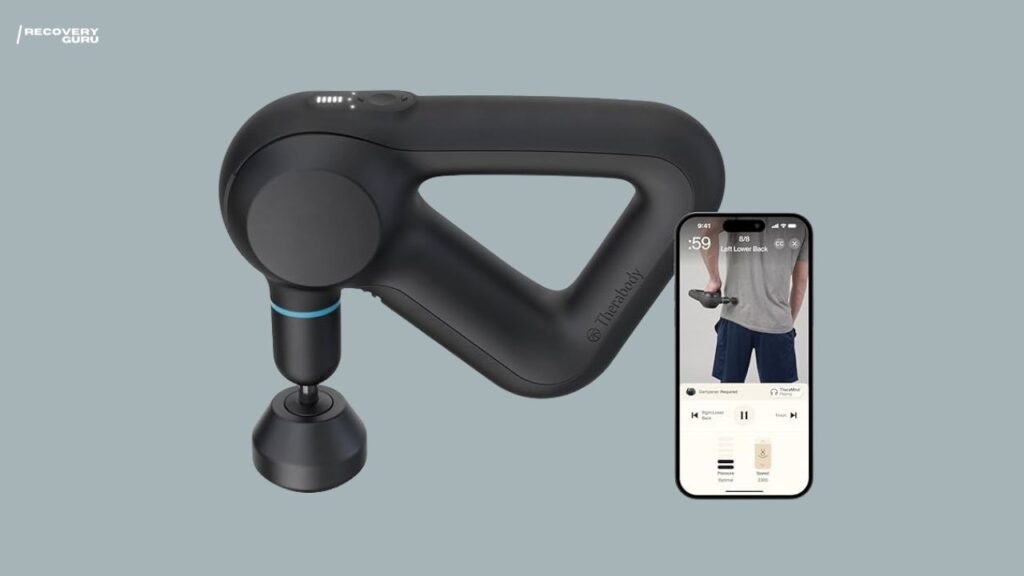
As we hit 2025, massage guns have started incorporating more smart tech features. While not a must-have, these can enhance your experience. Some examples include:
Bluetooth App Integration: Certain devices (from brands like Therabody or Hyperice) connect to a smartphone app. These apps can show you guided massage routines for different body parts, track your usage, and even adjust the gun’s speed automatically based on the routine. It’s like having a coach telling you where to massage and for how long. For instance, if you finish a run, the app might guide you through a 10-minute leg recovery massage, switching the gun off after each muscle group’s recommended time.
Pressure Sensors: High-end guns sometimes have a built-in pressure indicator – for example, lights that change color depending on how hard you’re pressing. This can help you apply consistent pressure or avoid pressing too hard. The app may also display pressure in real time.
Memory and Customization: A few models let you save custom speed settings or programs, so you can quickly access your favorite routine.
Thermal or Vibro Feedback: While still uncommon, some massage guns have begun exploring attachments that can heat up or provide additional vibration patterns. A heated attachment could, in theory, combine heat therapy with percussion (though this is still niche).
USB-C Charging: A minor “smart” convenience – some smaller devices now use USB-C, meaning you can charge them like a phone, and maybe even use a power bank. Not really smart, but a modern feature.
It’s worth considering if these extras matter to you. For a tech-savvy user or someone who likes structured guidance, an app-connected device can be very useful. If you’re more old-school and just want to manually handle your massage, you might not care about connectivity.
Keep in mind, smart features often come at a premium price. Also ensure the device works well without the app if you don’t want to always use it (most do, the app is optional). Check compatibility of the app with your phone as well.
9. Price and Warranty
Massage guns can range anywhere from around $50 to $500. Generally, you get what you pay for, but there are also many mid-range options that offer excellent performance without the top-tier price. Here’s how it roughly breaks down:
Budget range (<$100): These are basic devices. Many unknown brands or generic models fall here. They can still work fine, but often have lower amplitude, less stall force, and may not be as durable. They might include lots of attachments and claim high specs, but be cautious of marketing exaggeration. If you just want to try out percussive massage without big investment, you can find decent budget ones – just read reviews.
Mid-range ($100-$250): This is the sweet spot for many well-rounded massage guns. Here you find devices with solid power, 3-5 attachments, good battery life, and moderate noise. They might lack some bells and whistles of the pricier models (or slightly less amplitude/stall force than the absolute best), but for most users, these are more than sufficient. Many reputable brands have mid-tier models in this bracket.
High-end ($250-$500): Top-of-the-line products from leading brands often fall here. These guns typically have maximum amplitude and stall force, premium build quality, the newest features (apps, etc.), and often a robust warranty. If you’re an athlete or will use it daily and heavily, investing here could pay off in longevity and performance. For example, Theragun PRO or Hyperice’s high-end offerings are in this range.
Consider your budget and how important a massage gun is to your routine. Also, factor in warranty and customer support. A good device should come with at least a 1-year warranty, preferably 2 years for higher-end. This covers manufacturing defects. Some cheaper models might only have 6 months or require contacting a seller overseas for issues, which can be a hassle.
Established companies (Therabody, Hyperice, Ekrin, etc.) usually have better support and easy warranty service. Given that a massage gun is a mechanical device with moving parts, things can occasionally go wrong (motors burn out, batteries degrade). Knowing you have reliable warranty service is part of the buying decision. Additionally, check if the battery is replaceable or if the company offers repairs after warranty (for expensive models).
10. Reviews and Real-World Feedback
Finally, do some research on user reviews for the models you’re considering. Specs are important, but real-world use will tell you if the device lives up to them. Look for feedback on:
How powerful it feels.
Ease of use and handling.
Any durability issues.
Battery performance matching claims.
Noise levels in practice.
Customer service experiences.
Often, newer brands might have great value but unknown longevity, so early reviews help. By 2025, some brands have established track records in the massage gun space (Theragun/Therabody, Hypervolt/Hyperice, Ekrin Athletics, TimTam, etc.).
Also, consider any specific needs you have: for example, if you plan to use it for travel, see if people mention travel-friendliness. If you have smaller hands, see if anyone comments on the grip size. Since a massage gun is a device you’re likely to use frequently, it’s worth taking the time to pick one that suits you well.
Making Your Decision: Putting It All Together
When buying a massage gun, start by clarifying your own needs and use cases. Are you an athlete needing intense deep tissue work on large muscles? Then prioritize amplitude, stall force, and battery life. Are you looking for something to work out knots in your neck and shoulders at the office or after work? You might favor a quieter, lighter model that’s easy to handle, even if it’s not the most powerful. Do you travel a lot? Then size and battery (and maybe USB-C charging) might be key. If you love tech, a smart app-enabled device could keep you engaged in using it regularly.
Try before you buy, if possible. Some sporting goods stores, physical therapy clinics, or even mall kiosks have units you can test. Feeling the difference in vibration and weight can immediately tell you what you prefer. If that’s not an option, watching video reviews online can demonstrate how the massage gun operates (and give a sense of its noise and intensity).
Remember that the market is quite saturated – which is good news for buyers because competition drives innovation and better prices. Many mid-level devices now offer performance close to the flagships at a lower cost. But also be wary of deals that seem too good to be true (like a $300-spec device being sold for $60 by a no-name brand). There’s often a catch in build quality or longevity.
Accessories like a carrying case are a nice bonus to look for. Most guns come with a case or pouch, which is handy for storage and travel. If not, you might want to get one to keep the gun and attachments organized.
And when you’re ready to invest in one, look for the best massage guns in 2025 here.

